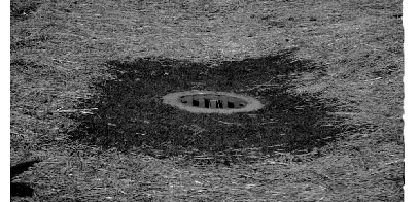
|

|
To Print Use The pdf File
ILLINOIS URBAN MANUAL
PRACTICE STANDARD
INLET PROTECTION - SOD FILTER
(no.)
CODE 862
 (Source: USDA - Natural Resources Conservation Service - Illinois) |
DEFINITION
A sediment filter formed around a storm drain drop inlet by the use of sod.
PURPOSE
The purpose of this practice is to help prevent sediment and mulch materials from entering storm drains before permanent seeding has become established in the contributing watershed.
CONDITIONS WHERE PRACTICE APPLIES
This method of inlet protection is applicable only for drop inlets at the time when permanent seeding of the contributing drainage area is completed.
CRITERIA
The drainage area shall be limited to 1 acre.
Sod shall be placed to form a turf mat that covers the soil for a minimum of 4 feet from each side of the inlet structure.
Final grading, soil preparation and installation of sod shall follow criteria in practice standard SODDING 925.
For sites where permanent seeding has not been completed, practice standards INLET PROTECTION - BLOCK & GRAVEL 850, INLET PROTECTION – EXCAVATED DRAIN 855, INLET PROTECTION – FABRIC DROP 860, INLET PROTECTION – GRAVEL & WIRE MESH 861, or INLET PROTECTION – STRAW BALE BARRIER 863 shall be utilized, as appropriate.
Filter fabric may be used under the storm sewer grate to enhance sediment removal. The fabric shall meet the requirements as shown in material specification 592 GEOTEXTILE, Table 1 or 2 Class 1 with an AOS of at least 30 for non-woven and 50 for woven. Use of the fabric may increase the frequency of maintenance.
CONSIDERATIONS
Storm drain inlet protection consists of several types of inlet filters and traps. Each type differs in application dependant upon site conditions and type of inlet. Not all designs are appropriate in all cases. The user must carefully select a design suitable for the needs and site conditions.
The best way to prevent sediment from entering the storm sewer system is to stabilize disturbed areas of the site as quickly as possible, preventing erosion and stopping sediment at its source.
For this practice to have its maximum effect, the sod must be flush with the surrounding ground surface.
Runoff from areas larger than one acre should be routed through a properly designed practice such as IMPOUNDMENT STRUCTURE-ROUTED 842, or TEMPORARY SEDIMENT TRAP 960.
PLANS AND SPECIFICATIONS
Plans and specifications for installing sod filter inlet protection shall be in keeping with this standard and shall describe the requirements for applying the practice to achieve its intended purpose. At a minimum include the following items:
All plans shall include the installation, inspection, and maintenance schedules with the responsible party identified.
Standard drawing SOD FILTER INLET PROTECTION PLAN IL-562 may be used as the plan sheet.
OPERATION AND MAINTENANCE
The structure shall be inspected after every runoff producing rain and repairs made as needed.
If the grate or filter fabric becomes clogged with sediment or mulch materials so that it no longer adequately performs its function, they must be pulled away from the inlet, and the grate and filter fabric cleaned and replaced.
Removed materials shall be deposited in a suitable area in such a manner that it will not cause problems.
REFERENCES
North Carolina Sedimentation Control Commission, 1988. Erosion and Sediment Control Planning and Design Manual. NC
Virginia Department of Conservation and Recreation, Division of Soil and Water Conservation, 1992. Virginia Erosion and Sediment Control Handbook. 3rd ed., VA
NRCS IL November 1999